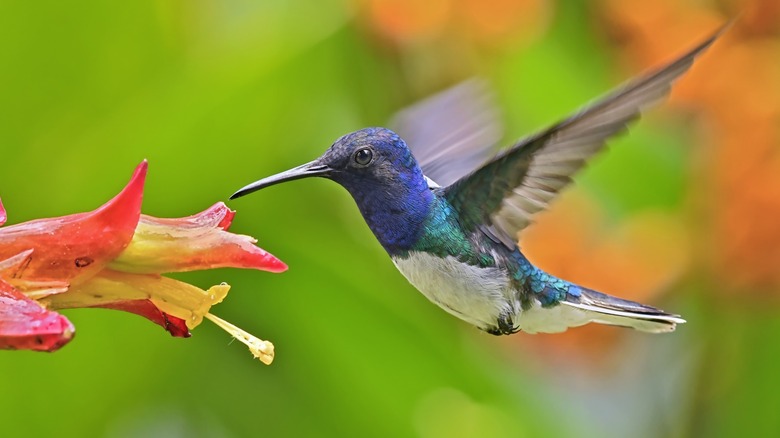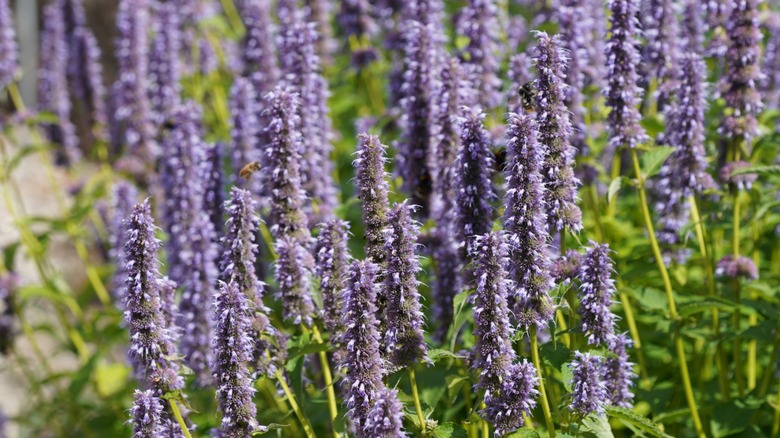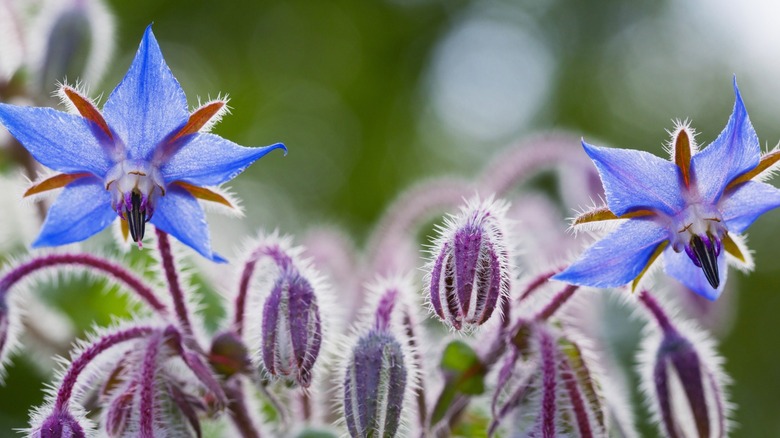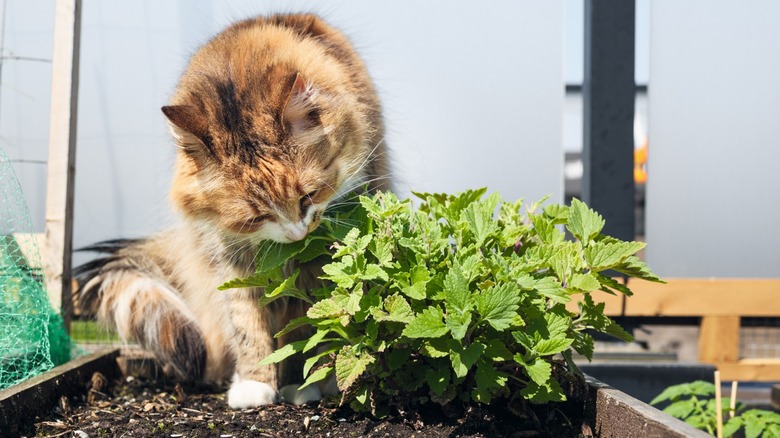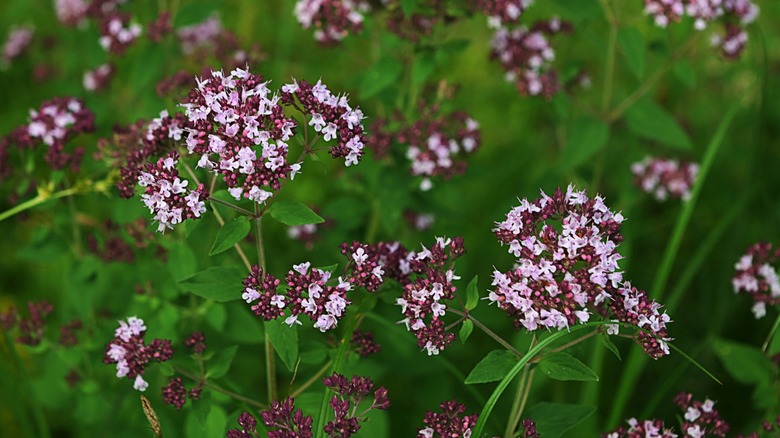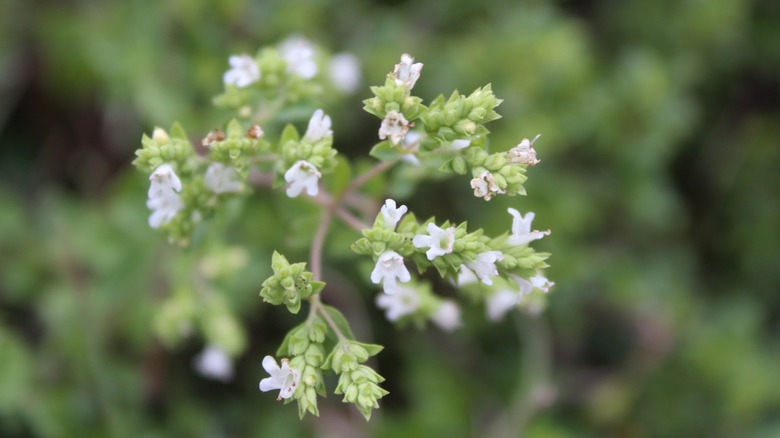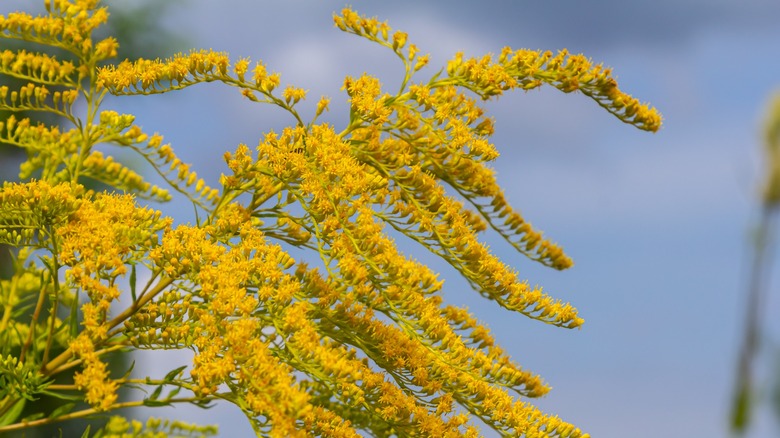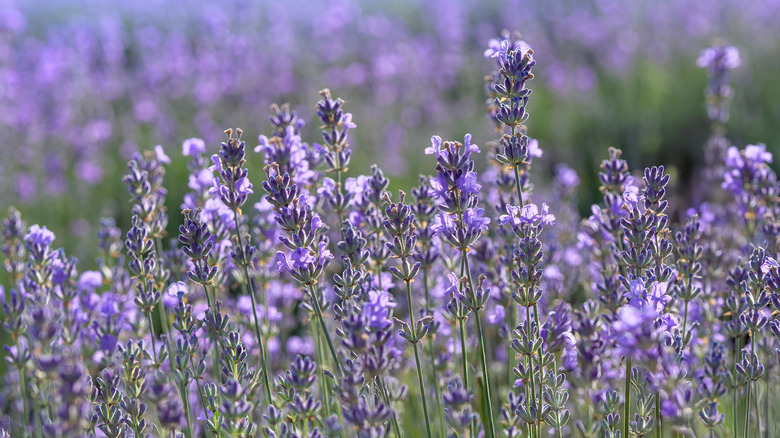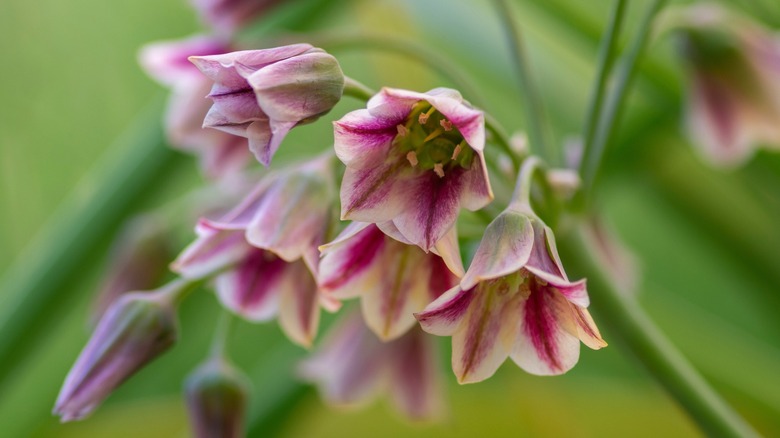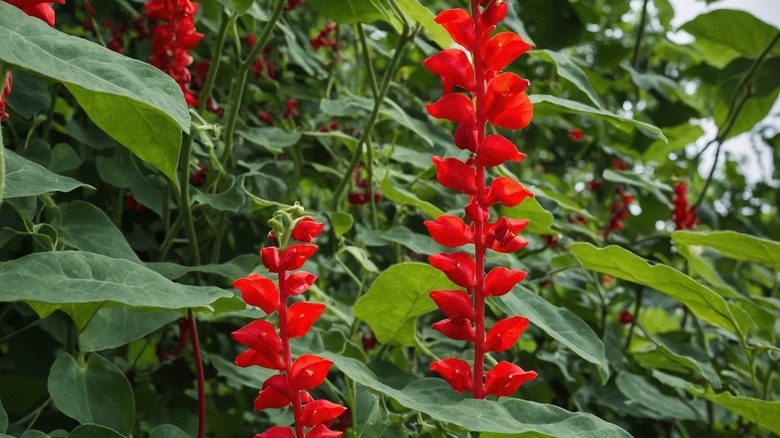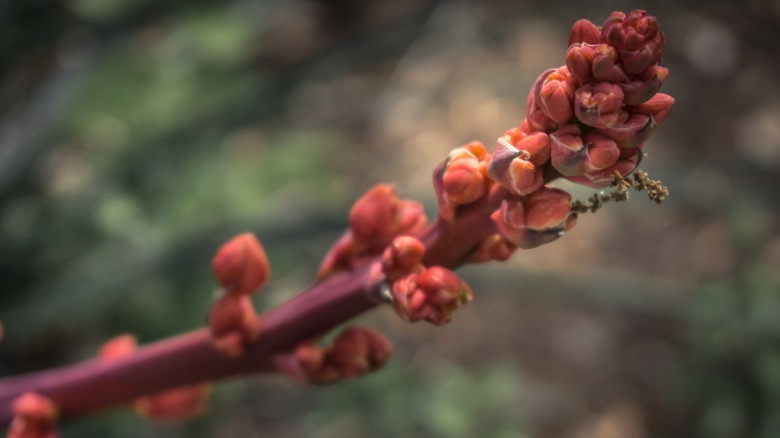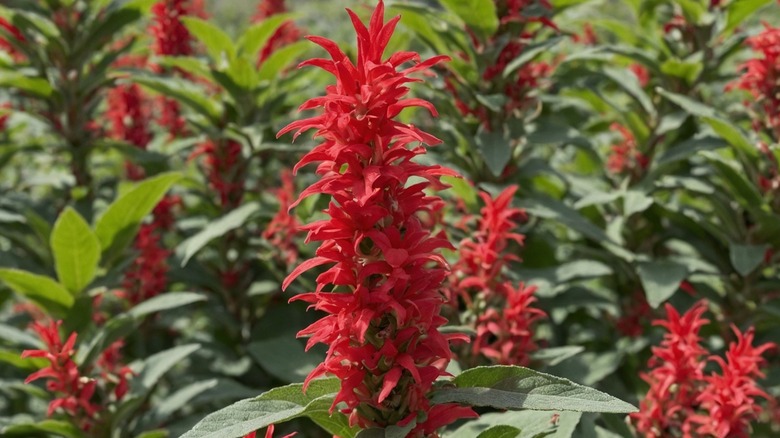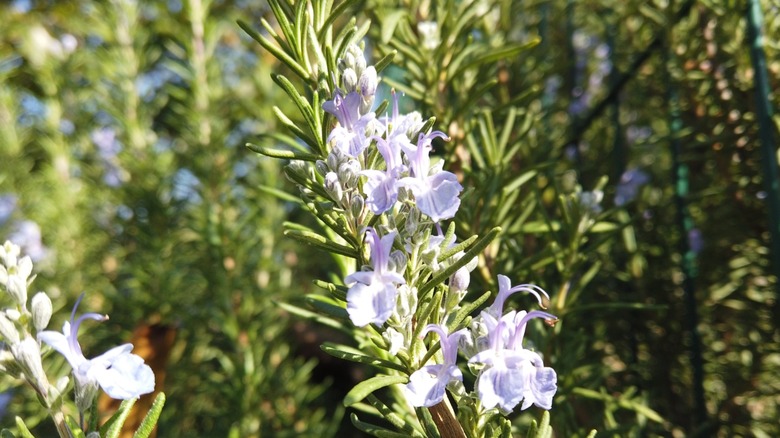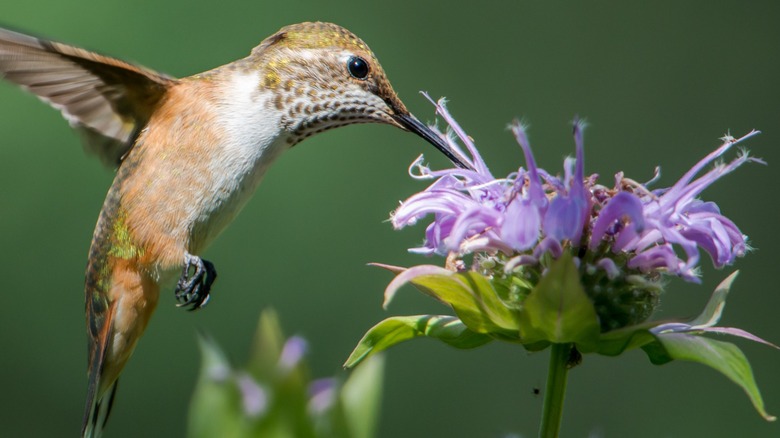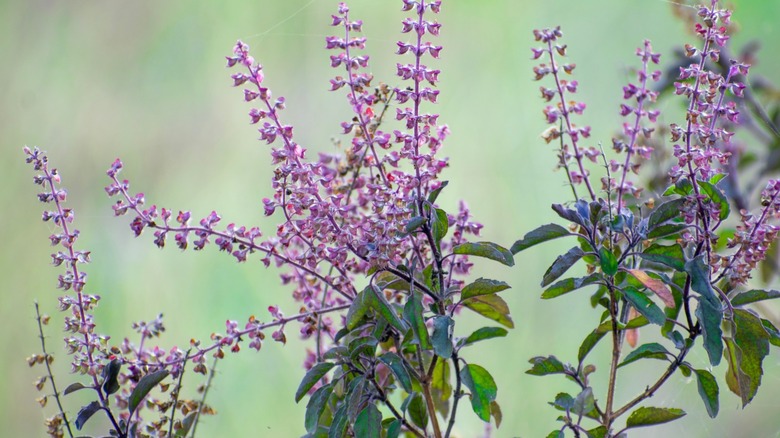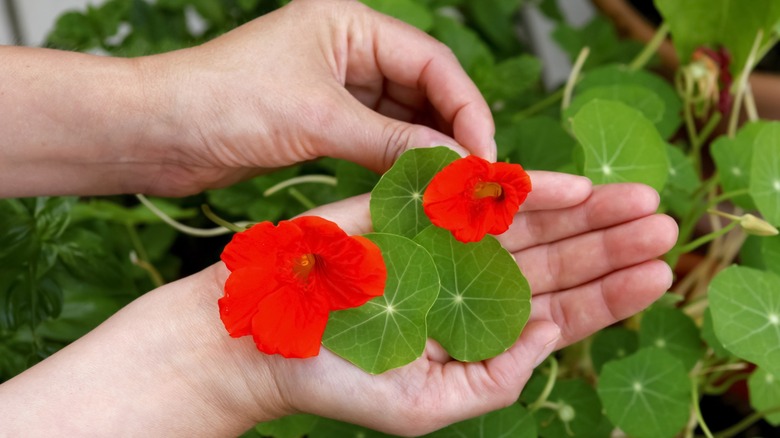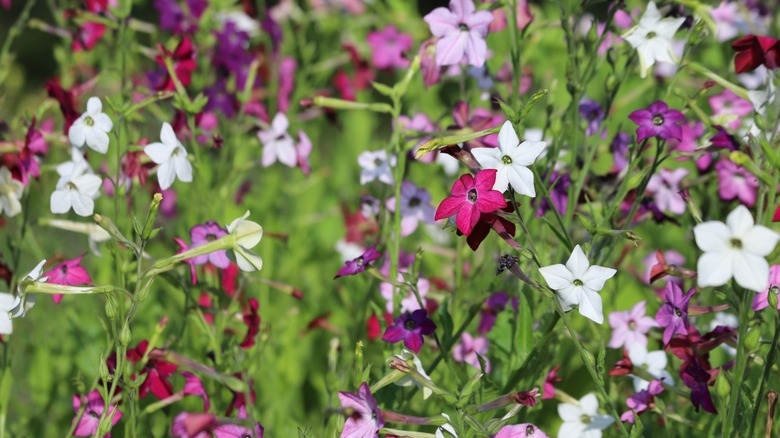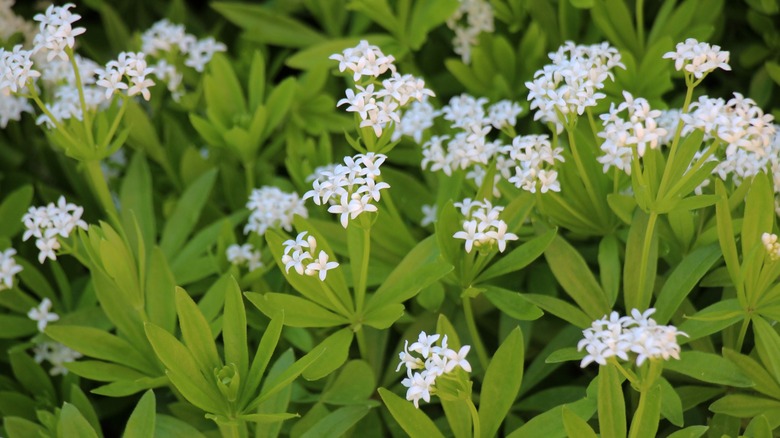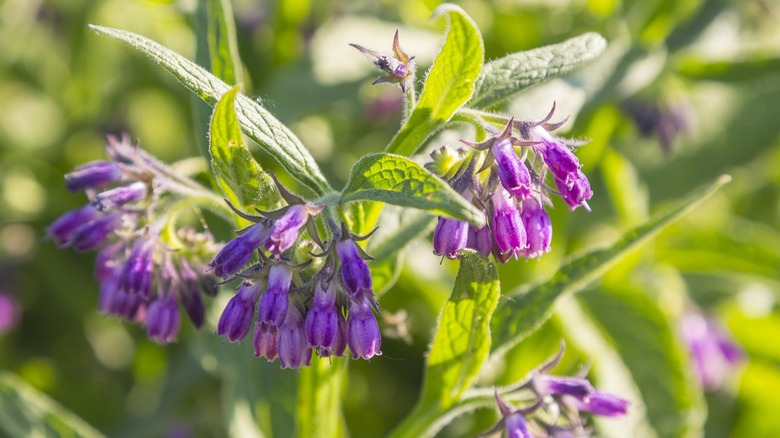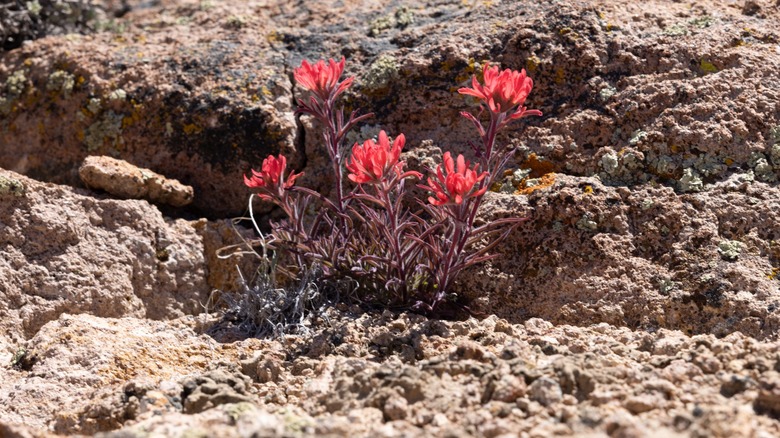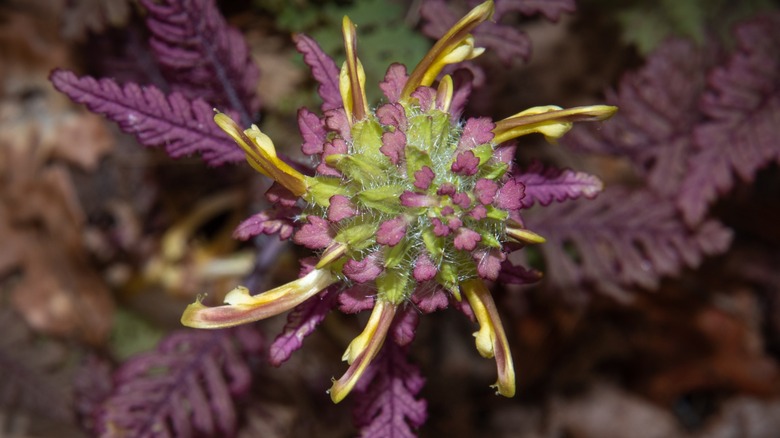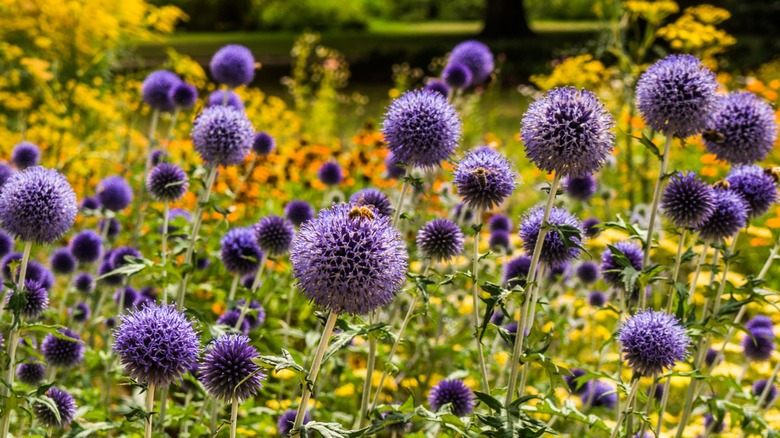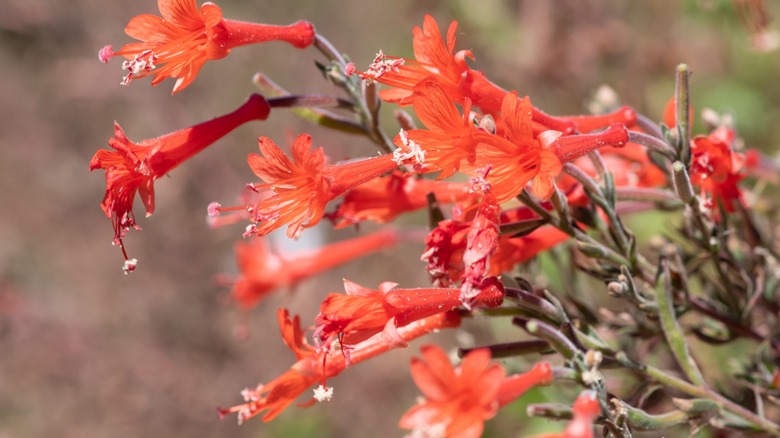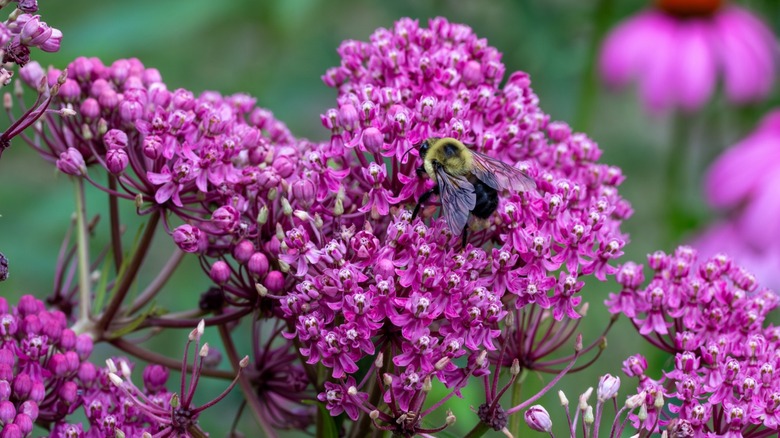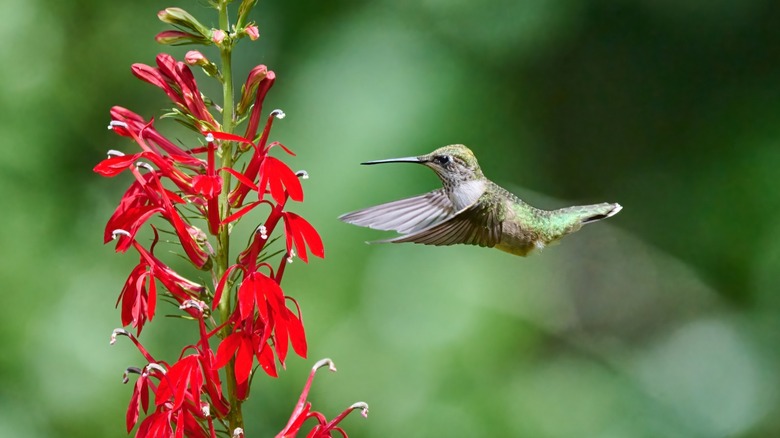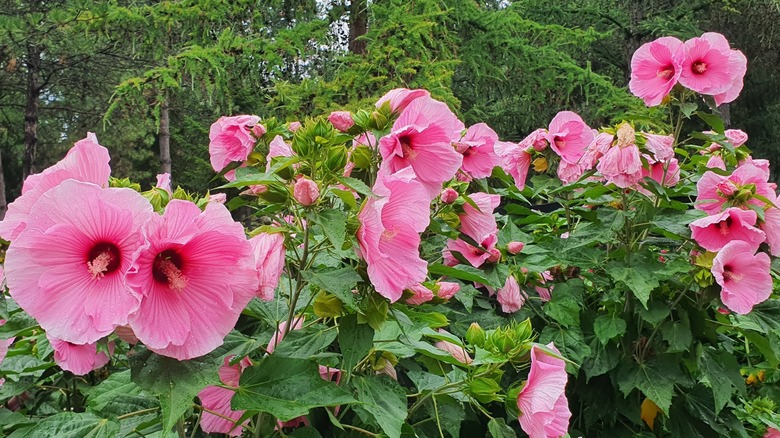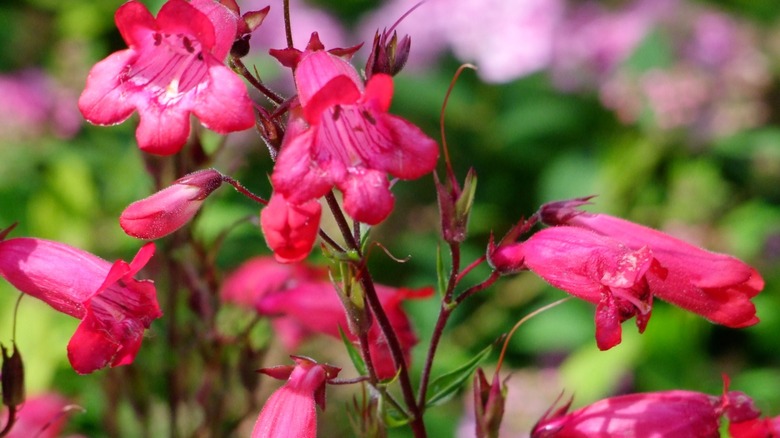27 Herbs You Should Grow To Attract More Hummingbirds To Your Garden
You've probably seen one of those videos of hummingbirds fluttering their tiny, iridescent wings about and immediately wished you had some of that beauty in your own backyard. Beyond how cute they are, these little birds make a big impact in any garden by keeping plants pollinated and productive.
Now, most people try to lure hummingbirds in by hanging feeders at strategic points. But anyone who's ever kept one would tell you that these hummingbird feeders are not exactly low-maintenance. You've got to constantly clean and refill the containers. And even then, the birds might only stop by briefly, if at all, for a quick sip.
That's why most experts consider feeders more of a supplement than a standalone solution. What really keeps hummingbirds coming back is a yard full of the plants they actually love. And what most people don't know is that some of the best flowers for the job actually grow on herbs. From salvia to mint, plenty of herbs shoot up tubular blooms rich in nectar, and hummingbirds love them because they're easy to spot and feed on.
What's even more interesting is that some of these plants are just as attractive to bees and butterflies. So, with the right mix of varieties, you can achieve a herb garden that's useful for feeding pollinators outside and occasionally useful inside your kitchen. Without further ado, let's go over some of the best herbs to plant if you want to turn your yard into a natural hummingbird hotspot.
Anise hyssop
Anise hyssop (Agastache foeniculum) is also known as hummingbird mint, and it's easy to see why. It has the two things hummingbirds love most: bright colors and plenty of nectar. Although the plant smells sweet, almost like licorice, hummingbirds don't have much of a sense of smell.
That fragrance, however, is still useful. It helps drive away deer and rabbits. You can even snip a few leaves to make tea. Overall, it's a pretty easy-to-grow herb in Hardiness Zones 3 through 8. As long as it gets full sun, it'll do just fine, even in dry, poor soil.
Borage
Historically, herbalists turned to borage (Borago officinalis) as a mood booster, and modern science has confirmed that it contains gamma-linolenic acid (GLA), an essential fatty acid that's helpful with treating autoimmune disorders and premenstrual stress.
The flowers, some of the truest blues you can easily grow in USDA Zones 2 to 11, can also improve the mood of your garden. They're so efficient at attracting pollinators some gardeners call them "bee bread." And hummingbirds are just as drawn to them as honeybees. The flowers have a salty cucumber flavor, making them a useful garnish for summer drinks, saladsm and sandwiches.
Catmint and catnip
Most people assume that catmint (Nepeta) and catnip (Nepeta cataria) are one and the same since both of them are fragrant, flowering herbs that cats love. But if you look closely, you'll notice that they're actually different. Catnip has softer, greenish-gray leaves and pale, straggly flowers. Catmint produces lavender-blue flowers that encourage hummingbirds to visit your yard.
Either one is a great addition to your garden, as hummingbirds love the nectar in the flowers. Both are hardy down to Zone 3, but catnip can thrive up to Zone 9 and catmint is best up to Zone 8.
Oregano
Most people only think of growing Oregano (Origanum vulgare) as a spice they can reach for when making dishes. However, it produces dense clusters of pink or purple flowers packed with nectar that tend to bloom over a long season, making them a reliable source of food for hummingbirds, butterflies, and native bees.
The way it grows, leafy and sprawling, makes it quite bushy. And you can trim it back to keep the plant compact. More blooms mean more food for the hummers. In USDA Zones 4 through 10, it's a hardy perennial that'll keep returning to serve you.
Marjoram
Marjoram (Origanum majorana) is the milder cousin of oregano that you've probably spotted in many Mediterranean recipes. You can use the leaves fresh or dried to season food or brew tea. Research has shown marjoram's leaves have strong antimicrobial and antispasmodic properties, making them a reliable remedy for soothing digestive issues and menstrual cramps. What you may not know is that you can also count on marjoram to reel in some hummingbirds. It's hardy in USDA Zones 9 to 10, and will flourish in containers, hanging baskets, and borders as long as it gets full sun and adequate water.
Goldenrod
Goldenrod (Solidago) is a herbaceous perennial that produces cheerful yellow flowers which are magnets for hummingbirds. If you live in Zones 2 though 8, this plant could be the perfect pop of color.
Beyond its visual appeal, it doubles as an herbal remedy. The genus name Solidago derives from Latin, meaning "to make whole" or "to heal." So, while it makes your garden whole by drawing hummingbirds in, goldenrod is also a rich source of antioxidants. Studies have shown that its antioxidant level is much higher that of both green tea and vitamin C.
Lavender
If you've got a backyard, you might be tempted to fill it with ornamental grass. But truthfully, you'd be better off planting lavender. For starters, lavender (Lavandula) is far easier to maintain in Zones 5 though 9. It doesn't need constant mowing, trimming, or watering like grass does.
And unlike plain grass, lavender actually gives something back. Its aromatic leaves fill your outdoor space with a pleasant scent, and its tall spikes of purple are magnets for hummingbirds, bees, and butterflies. You can also snip off some flowers to make your own essential oils, soaps, or homemade linen sprays.
Sicilian honey garlic
If you're thinking about planting onions, consider the more interesting allium known as Sicilian honey garlic (Nectaroscordum siculum).The leaves do smell like garlic when brushed, so consider it a natural way of keeping rodents out of your garden. And it's suitable for USDA Zones 5 to 10.
This plant produces umbels of bell-shaped flowers streaked with mauve and green. When the buds open, the insides are a mix of cream and mauve, while the outsides have a soft blue-green tint. It's such a striking display that bumblebees and even hummingbirds can't help but flock towards.
Scarlet runner bean
Hummingbirds are naturally drawn to bold reds more than almost any other color, and scarlet runner bean (Phaseolus coccineus), true to its name, produces both edible pods and vivid scarlet blooms that serve as beacons for pollinators all summer. Scarlet runner, perennial in USDA Zones 7 to 11 (annual elsewhere), can tolerate the cold better than regular green beans.
However, you have to slice it before cooking because it's much tougher. That's probably because its roots are hard at work fixing nitrogen in the soil so other plants close to it have a better chance of thriving.
Texas red yucca
Another native red flower you should be using to attract hummingbirds to your yard is Texas red yucca (Hesperaloe parviflora), also known as hummingbird yucca. It's native to Texas, so as you'd expect, it's one tough plant. It thrives in hot, dry conditions (Zones 6 though 10), as long as the soil drains well. Just plant it in full sun, and you're good to go.
Once established, this plant is practically low-maintenance. Although it's a late bloomer, that's not exactly a problem. It just means your garden is guaranteed to keep feeding hummers from mid-summer through fall.
Salvia
The Salvia genus includes a wide range of plants, from culinary sage (Salvia officinalis) to blue anise sage (Salvia guaranitica), hummingbird sage (Salvia spathacea), and pineapple sage (Salvia elegans). All of them produce fragrant leaves and have a long history of use in traditional medicine.
While some are more popular in the kitchen today than others, most salvias share one thing in common: they're excellent at attracting hummingbirds. Salvia guaranitica, for example, can grow up to six feet tall in Zones 8 to 10, making its nectar easy-to-reach for these little birds. For even more hummingbirds, try pairing salvias with petunias.
Rosemary
Rosemary (Salvia rosmarinus), formerly known as Rosmarinus officinalis, was recently regrouped as part of the Salvia genus. That means it's now officially in the same botanical family as blue anise sage and culinary sage.
Like most salvias, rosemary prefers full sun and well-drained soil, but it's not as fussy as culinary sage. It's generally more tolerant of drought and most soil types making it a good choice if you're fall anywhere between Zones 8 and 11. Even though it's not as showy as other salvias, it's still just as efficient at catching a hummingbird's attention when in bloom.
Wild bergamot
Honestly, the entire Monarda family has you covered when it comes to pollinators. But if you live in Zones 3 to 9, wild bergamot (Monarda fistulosa) is a great option to start with. Bees love it, butterflies flock to it, and hummingbirds can't seem to get enough. Once established, it's drought-tolerant, which makes it low-maintenance. However, being part of the mint family, it spreads by rhizomes, so it can get a little unruly if left unchecked. But a bit of thinning now and then is a small trade-off for a garden that buzzes with hummers all summer.
Basil
Of all the reasons to add basil to your garden, today, we'll focus on just three. First, basil (Ocimum basilicum) is a classic culinary herb that elevates everything from pasta to pizza. Second, it contains chemical compounds that repel mosquitoes and certain fungal pathogens, making basil excellent to grow near your tomatoes in particular. But perhaps the most overlooked benefit is basil's effect on pollinators. If you let your basil flower using a simple pruning trick, it produces tiny, tubular blooms that are packed with nectar, and will help bring the buzz to your yard in Zones 3 to 11.
Nasturtium
If you grow cucumbers in your vegetable garden (and you're in Zones 9 to 11), add nasturtium (Tropaeolum majus). One, it makes an excellent companion plant. Two, once both mature, they pair really well in salads. Both the leaves and flowers are entirely edible and spicy. That signature heat comes from mustard seed oil compounds, which also happen to be antimicrobial. But just before you bring them into the kitchen, as they burst into bloom, nasturtiums help attract pollinators. The flowers are just the right shape: tubular enough for hummingbirds and vibrant enough they can be easily spotted.
Flowering tobacco
As you may have guessed, flowering tobacco (Nicotiana alata) is related to common tobacco (Nicotiana tabacum), but it's grown for ornamental purposes, not for smoking. Nonetheless, there are multiple reasons to consider planting flowering Nicotiana in your garden.
For Zone 10, it's a fragrant night-bloomer that hummingbirds can't resist. The flowers open in the evening and release a sweet scent, making them ideal for moon gardens. And while the fragrance attracts pollinators, it also draws aphids and whiteflies to itself and traps them. That way, you can lure pests away from other vulnerable plants in the garden.
Sweet woodruff
Most homeowners love the idea of a well-manicured lawn, but the reality of upkeep often makes them rethink it. Before you give up, try sweet woodruff (Galium odoratum), a low-maintenance, weed-resistant lawn alternative that's particularly hardy in Zones 4 through 9. Its whorled leaves and dainty clusters of star-shaped white blooms offer hummingbirds food from spring to summer. Once established, it needs little attention beyond occasional watering during dry spells. The plant contains coumarin, which releases a mild, hay-like scent. The dried leaves have notes of vanilla and can be used as potpourri or a natural moth repellent.
Comfrey
In traditional medicine, comfrey (Symphytum officinale) is a herb once believed to soothe bruises, sprains, and even broken bones. However, modern medical experts advise you don't ingest comfrey because it can possibly harm the liver. But that doesn't mean you shouldn't plant it. Its colorful, bell-shaped flowers do a fine job of attracting hummingbirds. As a bonus, this plant helps you achieve healthy soil in the garden. Just make sure you avoid the mistake most people make when planting comfrey by carefully choosing a spot. Anywhere between Zones 4 to 8 works; but once established, moving it isn't easy.
Prairie paintbrush
Prairie paintbrush (Castilleja purpurea), also known as Indian paintbrush, is one of the best native plants to grow if you live in the Mountain West or anywhere in Zone 4 to 8. Its vivid red bracts are hard to miss, especially for hummingbirds. And because they're bracts, not petals, hummingbirds can enjoy the nectar without much competition from insects.
What's more interesting is it's hemiparasitic, which means it taps into the roots of neighboring plants to draw extra nutrients. This dependency makes it selective about where it grows. It needs full sun, well-drained soil, and the right companions.
Wood betony
Wood betony (Pedicularis canadensis) is another hemiparasitic herb that hummingbirds will visit. Now, even though it depends on the roots of surrounding plants for additional nutrients, it doesn't harm them. In fact, because it's sharing resources with its neighbors, it's a good idea to pair it with any competitive grasses you'd rather not spend much time trimming in your garden. It thrives particularly well in Zones 4 to 8. In the past, it was used as a herbal remedy for stomach aches and sores. Today, some use wood betony-infused oil in massages to soothe tense muscles.
Globe thistle
Some people expect herbaceous plants to be purely functional, but our list proves they can produce some of the most interesting flowers in the garden. Globe thistle (Echinops ritro) is a good example. This self-seeding perennial, hardy to Zones 3 through 9, is particularly rich in antioxidants, antimicrobial compounds, and even natural insecticidal properties. This means it can help neutralize free radicals, fend off pests, and combat a range of bacteria and fungi. Yet, it still adds striking color to your garden year after year, thanks to its steel-blue, spherical blooms. And those flowers are magnets for hummingbirds.
California fuchsia
This tall herbaceous perennial is also called hummingbird trumpet (Epilobium canum), and as you can guess, it looks like a trumpet and does a good job of attracting hummers. It's native to the southwestern region of the United States, so that means it can thrive in Zones 8 through 11, where the soil is rocky and the sun is relentless. But what's most impressive is how generous it is in return. Even when most plants start to fade, California fuchsia keeps blooming. And if you water it properly, you can stretch that bloom window out longer.
Swamp milkweed
Swamp milkweed (Asclepias incarnata) is most at home in Zones 3 to 9, but it's surprisingly adaptable and will settle in easily as long as the soil holds a bit of moisture. In summer, it produces soft pink flowers that are fragrant, but more importantly, full of nectar. This makes it a certified favorite among hummingbirds and monarch butterflies. For monarchs, in particular, it provides them a place to lay their eggs and food for the caterpillars once they hatch. And even after it matures, it'll return again to ensure there's no shortage of pollinators in your yard.
Cardinal flower
Cardinal flower (Lobelia cardinalis) is red, so you already know what that means: the hummers love it. And yes, the name is in fact a reference to the bright red robes that Roman Catholic cardinals wear. We can't speak for popes, but this plant is almost always thirsty. That's why you'll typically find it in woodlands, wet meadows, or growing along the edges of rain gardens in Zones 3 to 9. If you're thinking of adding it to your space, you have to be careful because it's mildly flammable when dry. Interestingly, it pairs beautifully with swamp milkweed.
Rose mallow
Some people know rose mallow (Hibiscus moscheutos) as swamp hibiscus because it thrives in wetlands. But it loves the sun just as much, making it a perennial hardy to USDA Zones 4 to 9. Other people call it the "dinner-plate" hibiscus because of its huge, saucer-shaped flowers, which come in white, pink, or red shades, sometimes with deep crimson centers. And as you can guess, the bigger the flower, the easier it is for pollinators to spot from a distance. So, with this in your garden, you'll have hummingbirds, bees, and butterflies visiting from summer into fall.
Penstemon
By now, you get the gist: hummingbirds love tubular, colorful, nectar-rich flowers. And Penstemon, especially the native Eastern smooth beardtongue (Penstemon laevigatus), checks all three boxes. It grows in spires of tubular flowers, often in soft shades of violet, lavender, or pale pink.
Even though it's native to the eastern part of the United States, this herbaceous perennial thrives in woodlands and meadows. Once established, it's drought-tolerant, prefers full sun to light shade, and can handle both dry, rocky soil and rich, moist garden beds. And thanks to its fibrous root system, it's also pretty helpful with erosion control.
